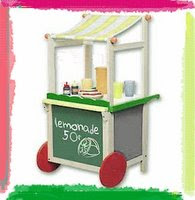Thursday, September 30, 2010
FDA Warns Parents About Sleep Positioners
They may sound like a good idea, but they aren't. Follow this link to read why.
Fisher-Price Recalls More than 10 Million Products
Follow this link to find out exactly which products pose a danger to your children.
Wednesday, September 22, 2010
Have a Car Seat in Your car?
This Saturday, September 25th is “National Seat Check Saturday” when certified child passenger safety technicians will provide child safety seat inspections for free! Here's a link to the National Highway Traffic Safety Administraiton to find a child safety seat inspection station near you.
Monday, September 20, 2010
Friday, September 17, 2010
Award Received
I am so proud to announce that my blog has received an award for being one of the best grandparent sites for 2010. I was chosen by Grand Magazine, an online magazine for grandparents. There are many interesting articles, news items and tips. You can see the current issue here.
Thursday, September 16, 2010
Creating a Postive Youth Sports Experience
Follow this link to an article in the American Academy of Pediatrics newsletter
Saturday, September 11, 2010
September 2010 Book Recommendations
I was just enjoying the wonderful fresh apples available from my local Farmer's Market, and I thought that for September, I would use them as my reading and activity theme. I have two terrific books to recommend.
First, The Crooked Apple Tree, written by Eric Houghton and illustrated by Caroline Gold, published by Barefoot Books, New York. In this delightful story, two children use their imaginations to play under a crooked old apple tree. Although they don't think much of the old tree, they appreciate it more after looking at the photographs their Dad had taken of it throughout the year.
Second, The Apple Pie Tree, written by Zoe Hall illustrated by Shari Halpern, published by Blue Sky Press, New York. There are two children in this story who adore their apple tree and spend the year in anticipation of it's wonderful gift-apples! They watch it throughout the seasons and get to pick the apples and make themselves a delicious pie. The last page of the book explains the importance of bees to pollination, and gives instructions on how to make the perfect apple pie.
Activity: For a change of pace, I decided this month instead of a craft, I would offer two child friendly, simple apple recipes. Cooking with children is a rewarding experience. Besides giving them good skills for later life, it offers parents the opportunity to introduce new language, as well as the skills of measuring, fractions, reading, telling time, sequencing, and nutrition.
This activity must be done with an adult.
Apple Cream Pie
4 cups of peeled and diced apples
1 cup of sugar
1 cup of half and half
2 tablespoons of flour
Combine all the ingredients. Pout into unbaked pie shell. Bake 45 minutes to 1 hour or until brown at 350 degrees.
Apple Crisp
1/3 cup of butter softened
1 cup of brown sugar
3/4 cup of flour
4 cups of sliced tart apples
Mix butter, sugar and flour. Place apples in a 8x8 inch pan. Sprinkle butter topping over the apples. Bake at 350 degrees for 1 hour.
Pour two glasses of cold milk and enjoy!
First, The Crooked Apple Tree, written by Eric Houghton and illustrated by Caroline Gold, published by Barefoot Books, New York. In this delightful story, two children use their imaginations to play under a crooked old apple tree. Although they don't think much of the old tree, they appreciate it more after looking at the photographs their Dad had taken of it throughout the year.
Second, The Apple Pie Tree, written by Zoe Hall illustrated by Shari Halpern, published by Blue Sky Press, New York. There are two children in this story who adore their apple tree and spend the year in anticipation of it's wonderful gift-apples! They watch it throughout the seasons and get to pick the apples and make themselves a delicious pie. The last page of the book explains the importance of bees to pollination, and gives instructions on how to make the perfect apple pie.
Activity: For a change of pace, I decided this month instead of a craft, I would offer two child friendly, simple apple recipes. Cooking with children is a rewarding experience. Besides giving them good skills for later life, it offers parents the opportunity to introduce new language, as well as the skills of measuring, fractions, reading, telling time, sequencing, and nutrition.
This activity must be done with an adult.
Apple Cream Pie
4 cups of peeled and diced apples
1 cup of sugar
1 cup of half and half
2 tablespoons of flour
Combine all the ingredients. Pout into unbaked pie shell. Bake 45 minutes to 1 hour or until brown at 350 degrees.
Apple Crisp
1/3 cup of butter softened
1 cup of brown sugar
3/4 cup of flour
4 cups of sliced tart apples
Mix butter, sugar and flour. Place apples in a 8x8 inch pan. Sprinkle butter topping over the apples. Bake at 350 degrees for 1 hour.
Pour two glasses of cold milk and enjoy!
Wednesday, September 8, 2010
Product Recalls For August 2010
Follow this link for the children's products that have been recalled.
New Ratings For Booster Seats
Follow this link to the Insurance Institute of America and read the newest ratings and information.
Sunday, September 5, 2010
September Math Everyday
In response to requests for ideas that supplement and enhance mathematical learning for young children, I am offering my first topic of sorting and classifying. To many, this may not appear to have much mathematical significance, but rest assured it does. It is important that children begin to think about how objects, people and places have attributes in common. An attribute is defined as a quality or characteristic belonging to a person or thing or a distinctive feature. Children can be given a collection of everyday objects and asking to sort them any way they want.
Examples of beginning rules for sorting are:
1.color
2.shape
3.size-big small, thick, thin, long, short
4.appearance-shiny, dull, decorated, plain
5.material- wood, metal, plastic, glass
6.use-play, work, school
You can use objects in you home for this activity, such as laundry, food, toys, books, writing/drawing instruments, office supplies and many others.
Two easy activities to practice:
1. Point out the various places where sorting is very apparent, such as supermarkets, where similar foods are grouped. See if you child can name the rule for sorting in each aisle, for example, produce, dairy, candy, meat, soda. Other good places to use this activity is department and hardware stores, pharmacies, and libraries. Discuss with your child how your shopping would change if items were not sorted. Additionally, menus are another easy way to show how sorting is used everyday. Children can use circulars to cut out pictures and glue them into sorted groups. Help your child label each list or group correctly. Point out how items are arrranged in their closet and dresser, in your pantry or kitchen.
Extensions: a.You name several items, see if your child can label your group of
items.
b.Name several items that belong to a group and one that doesn't.
See if you child can pick out the one that doesn't belong.
2. For older children, the Venn diagram can be used. This diagram using overlapping circles, shows how items are related. In the example below, I have chosen to use items in a child's room. I have two groups, "items in my room", and "items that are blue" as my labels. There are items listed inside each circle. The higher level thinking skills come from deciding which items belong where two circle overlap. These items must fit both rules. Your older child can draw these circles or you can use yarn or string to make them so they can be reused each time. At first, you can give the ideas to your child and let them create the diagram. Later on they will be able to do it using their own rules and items.
Extensions: a. Items can become more similar so that careful thought must be used.
Jar lids, stamps, and buttons would be a great example.
b. A third circle might be added so that three attributes must be
considered.

Hope you enjoy using these ideas with your children and find ways to extend and expand them. Remember to teach math everyday.
Examples of beginning rules for sorting are:
1.color
2.shape
3.size-big small, thick, thin, long, short
4.appearance-shiny, dull, decorated, plain
5.material- wood, metal, plastic, glass
6.use-play, work, school
You can use objects in you home for this activity, such as laundry, food, toys, books, writing/drawing instruments, office supplies and many others.
Two easy activities to practice:
1. Point out the various places where sorting is very apparent, such as supermarkets, where similar foods are grouped. See if you child can name the rule for sorting in each aisle, for example, produce, dairy, candy, meat, soda. Other good places to use this activity is department and hardware stores, pharmacies, and libraries. Discuss with your child how your shopping would change if items were not sorted. Additionally, menus are another easy way to show how sorting is used everyday. Children can use circulars to cut out pictures and glue them into sorted groups. Help your child label each list or group correctly. Point out how items are arrranged in their closet and dresser, in your pantry or kitchen.
Extensions: a.You name several items, see if your child can label your group of
items.
b.Name several items that belong to a group and one that doesn't.
See if you child can pick out the one that doesn't belong.
2. For older children, the Venn diagram can be used. This diagram using overlapping circles, shows how items are related. In the example below, I have chosen to use items in a child's room. I have two groups, "items in my room", and "items that are blue" as my labels. There are items listed inside each circle. The higher level thinking skills come from deciding which items belong where two circle overlap. These items must fit both rules. Your older child can draw these circles or you can use yarn or string to make them so they can be reused each time. At first, you can give the ideas to your child and let them create the diagram. Later on they will be able to do it using their own rules and items.
Extensions: a. Items can become more similar so that careful thought must be used.
Jar lids, stamps, and buttons would be a great example.
b. A third circle might be added so that three attributes must be
considered.

Hope you enjoy using these ideas with your children and find ways to extend and expand them. Remember to teach math everyday.
Subscribe to:
Posts (Atom)









